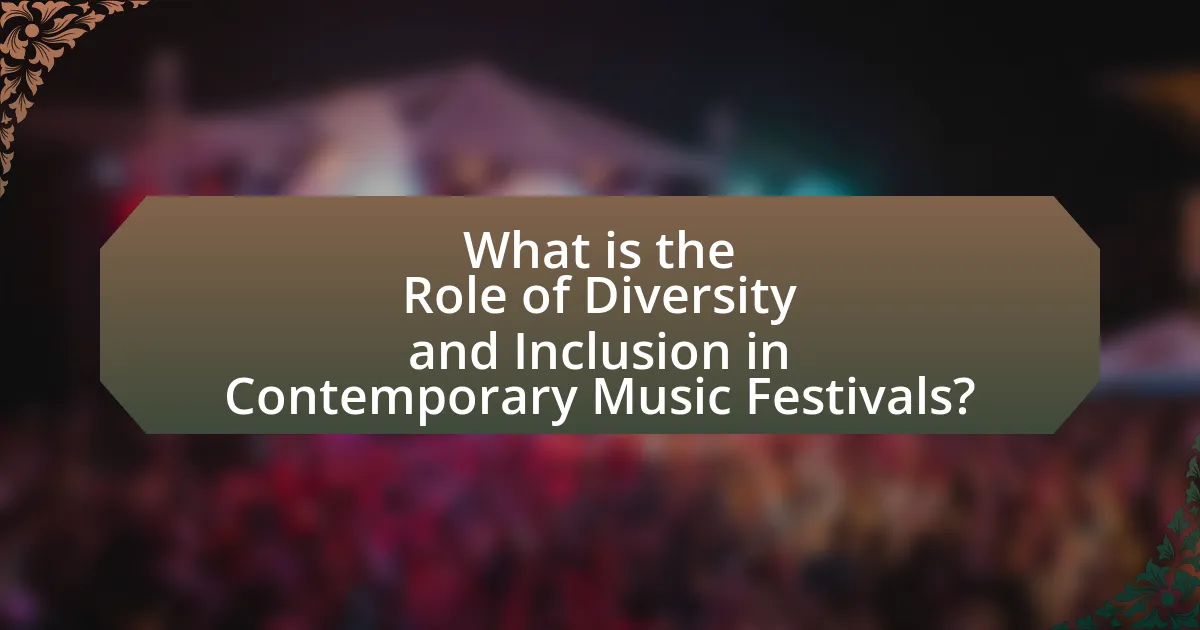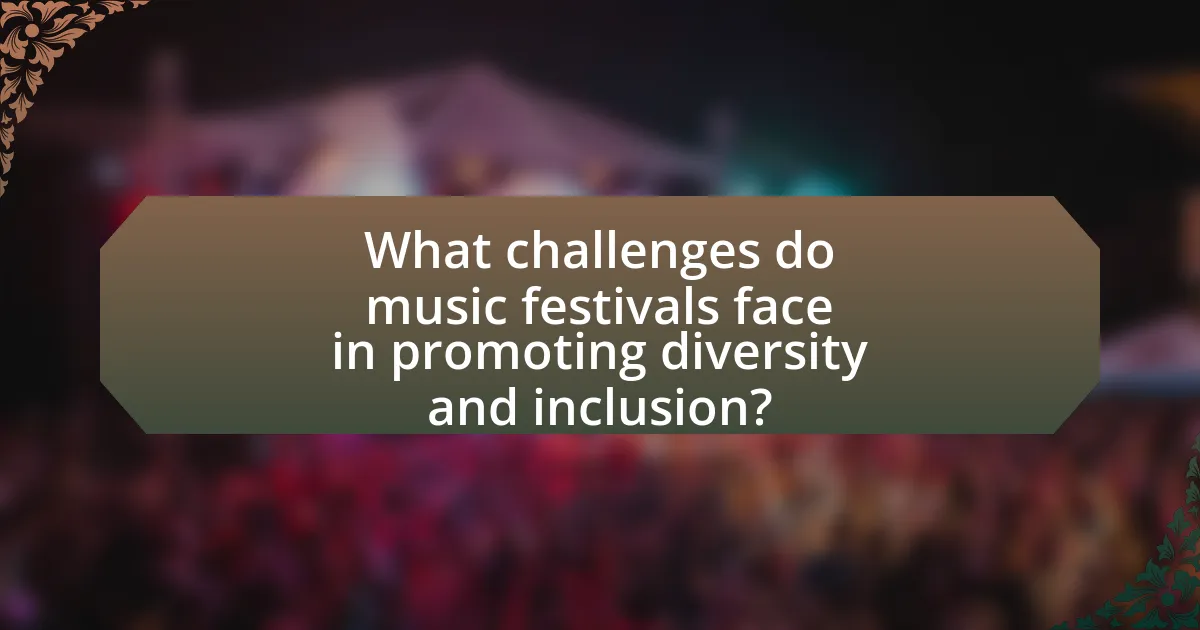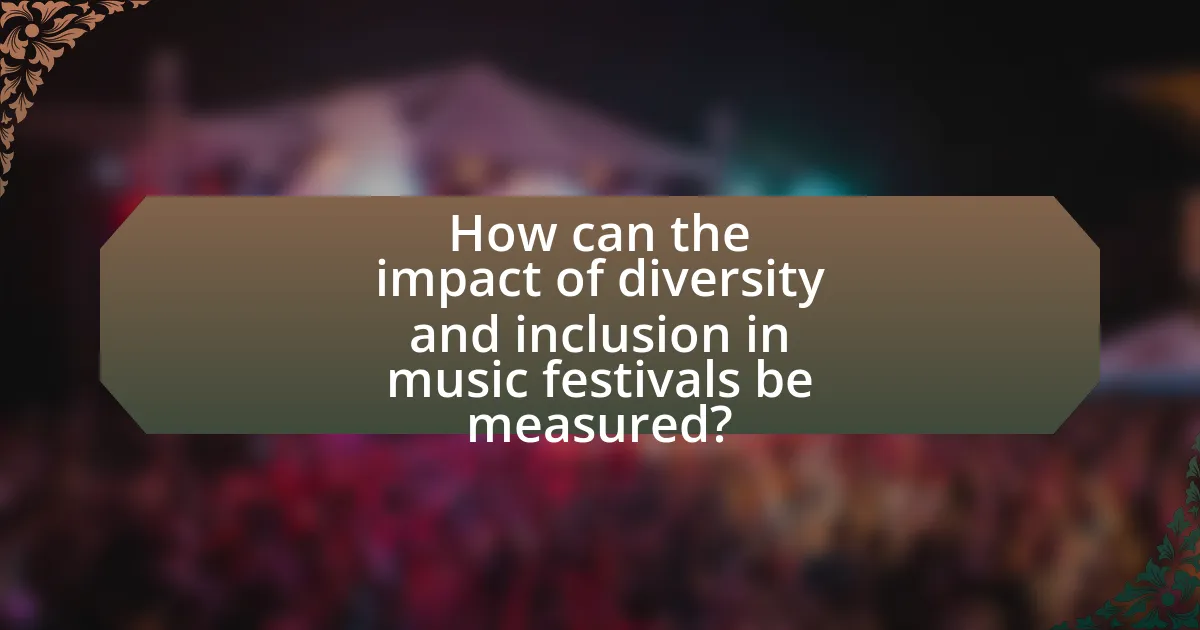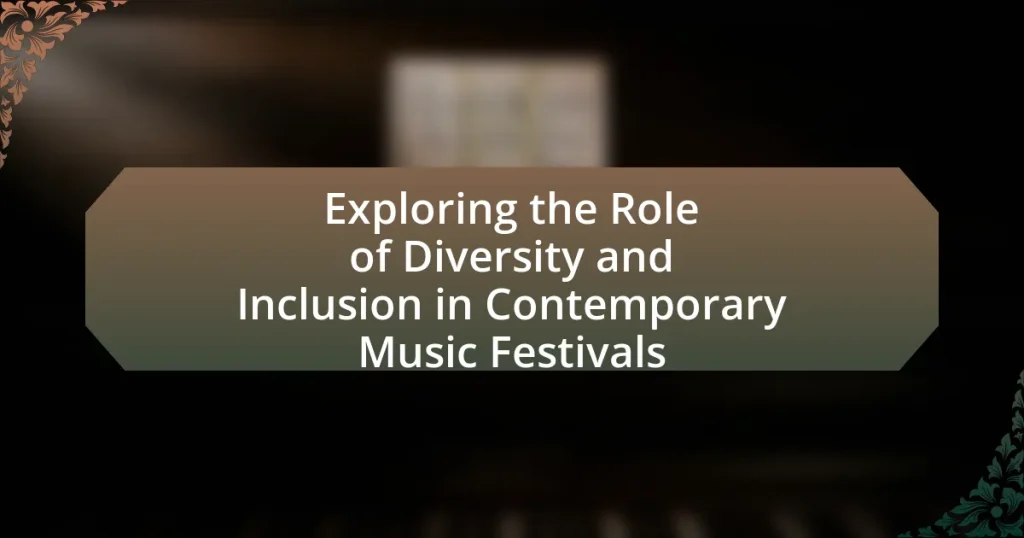The article explores the critical role of diversity and inclusion in contemporary music festivals, emphasizing their importance in creating a representative cultural experience. It examines how diverse programming enhances audience engagement and satisfaction, highlighting successful examples like Coachella and Glastonbury. The article also addresses the challenges festivals face in promoting inclusivity, such as systemic barriers and industry biases, while proposing strategies for improvement, including community partnerships and inclusive marketing practices. Additionally, it discusses the impact of emerging technologies and shifting audience expectations on diversity initiatives within the festival landscape.

What is the Role of Diversity and Inclusion in Contemporary Music Festivals?
Diversity and inclusion play a crucial role in contemporary music festivals by fostering a more representative and enriching cultural experience. These festivals aim to showcase a wide array of musical genres and artists from various backgrounds, which not only enhances the artistic offerings but also attracts a broader audience. For instance, festivals like Coachella and Glastonbury have increasingly prioritized diverse lineups, reflecting the demographics of their attendees and promoting underrepresented artists. Research indicates that diverse teams and inclusive environments lead to greater creativity and innovation, which is essential for the evolving landscape of music festivals. By embracing diversity and inclusion, festivals contribute to social change and community building, making them more relevant and impactful in today’s society.
How do diversity and inclusion manifest in music festival programming?
Diversity and inclusion in music festival programming manifest through the intentional selection of artists from various backgrounds, genres, and cultures, ensuring representation across gender, race, and socioeconomic status. For instance, festivals like Coachella and Glastonbury have made concerted efforts to feature a more diverse lineup, with Coachella reporting a 50% increase in female artists from 2019 to 2022. Additionally, programming often includes workshops, panels, and discussions that address social issues, fostering an inclusive environment for attendees. This approach not only enriches the festival experience but also reflects broader societal values, as seen in initiatives like the “We Are the Music Makers” program, which supports underrepresented musicians.
What types of diversity are represented in contemporary music festivals?
Contemporary music festivals represent various types of diversity, including racial, gender, cultural, and socioeconomic diversity. Racial diversity is evident as festivals increasingly feature artists from different ethnic backgrounds, reflecting a broader range of musical influences and traditions. Gender diversity is also prominent, with many festivals striving for gender parity in lineups, showcasing female artists across genres. Cultural diversity is highlighted through the inclusion of international acts and genres, promoting global music traditions. Socioeconomic diversity is represented by initiatives aimed at making festivals accessible to underprivileged communities, such as offering reduced ticket prices or free entry for certain groups. These efforts are supported by studies indicating that diverse lineups enhance audience engagement and satisfaction, demonstrating the importance of inclusivity in the music festival landscape.
How do inclusion practices enhance the festival experience for attendees?
Inclusion practices enhance the festival experience for attendees by fostering a sense of belonging and community among diverse groups. When festivals implement inclusive policies, such as accessible facilities, diverse programming, and representation of various cultures, they create an environment where all attendees feel valued and engaged. Research indicates that festivals with strong inclusion practices report higher attendee satisfaction and increased participation rates, as seen in the 2021 report by the Event Safety Alliance, which highlighted that inclusive events attract a broader audience and enhance overall enjoyment.
Why is diversity and inclusion important in the music festival industry?
Diversity and inclusion are crucial in the music festival industry because they enhance creativity, broaden audience engagement, and reflect societal values. Festivals that prioritize diverse lineups and inclusive environments attract a wider range of attendees, which can lead to increased ticket sales and sponsorship opportunities. For instance, a study by the Annenberg Inclusion Initiative found that diverse music festivals not only improve representation but also foster a sense of belonging among attendees, ultimately contributing to a more vibrant and dynamic cultural landscape. This alignment with contemporary social movements further strengthens the relevance and appeal of music festivals in today’s society.
What impact does diversity have on audience engagement and participation?
Diversity significantly enhances audience engagement and participation by fostering a sense of belonging and representation among attendees. When music festivals incorporate diverse artists and cultural expressions, they attract a broader audience, which leads to increased participation. Research indicates that events featuring diverse lineups see higher attendance rates; for instance, a study by the National Endowment for the Arts found that diverse programming can increase audience numbers by up to 30%. This inclusivity not only enriches the festival experience but also encourages attendees to connect with different cultures, ultimately driving higher levels of engagement and participation.
How does inclusion contribute to the overall success of music festivals?
Inclusion significantly enhances the overall success of music festivals by fostering a diverse audience and enriching the festival experience. When festivals prioritize inclusion, they attract a wider range of attendees, which can lead to increased ticket sales and greater community engagement. For instance, a study by the National Endowment for the Arts found that diverse programming can boost attendance by up to 30%, as it appeals to various cultural backgrounds and interests. Furthermore, inclusive practices create a welcoming environment that encourages participation from underrepresented groups, thereby enhancing the festival’s reputation and encouraging repeat attendance. This positive cycle of engagement and satisfaction ultimately contributes to the festival’s long-term viability and success.

What challenges do music festivals face in promoting diversity and inclusion?
Music festivals face significant challenges in promoting diversity and inclusion, primarily due to systemic barriers, financial constraints, and audience perceptions. Systemic barriers include a lack of representation in lineups and decision-making roles, which often perpetuates homogeneity. Financial constraints can limit the ability of festivals to invest in diverse talent and outreach programs aimed at underrepresented communities. Additionally, audience perceptions may influence programming choices, as festivals often cater to existing fan bases that may not prioritize diversity. These factors collectively hinder the effective promotion of diversity and inclusion within the festival landscape.
How do systemic barriers affect diversity in festival lineups?
Systemic barriers significantly limit diversity in festival lineups by perpetuating inequalities in access and representation. These barriers include economic disparities, lack of industry connections, and biases in selection processes that favor established artists over emerging talent from underrepresented groups. For instance, a study by the University of Southern California found that only 16% of festival lineups featured women artists, highlighting the impact of systemic gender bias. Additionally, festivals often rely on networks that exclude diverse voices, further entrenching homogeneity in programming. This lack of diversity not only affects the artists but also diminishes the cultural richness and audience engagement at festivals.
What role does industry bias play in festival programming decisions?
Industry bias significantly influences festival programming decisions by favoring established artists and genres that align with prevailing market trends. This bias often results in a lack of diversity, as festival organizers may prioritize familiar names over emerging or underrepresented talent. For instance, a study by the University of Southern California found that 70% of festival lineups predominantly feature artists from a narrow demographic, reflecting industry preferences rather than a broad spectrum of musical styles. Consequently, this bias can perpetuate systemic inequalities within the music industry, limiting opportunities for diverse voices and innovative expressions.
How can festivals overcome logistical challenges to enhance inclusion?
Festivals can overcome logistical challenges to enhance inclusion by implementing comprehensive accessibility plans that address transportation, venue layout, and resource allocation. For instance, ensuring that transportation options are available for individuals with disabilities can significantly increase attendance and participation. According to a study by the National Endowment for the Arts, accessible venues can lead to a 30% increase in audience diversity. Additionally, festivals can utilize technology, such as mobile apps, to provide real-time information about accessibility features and services, further promoting an inclusive environment. By prioritizing these logistical aspects, festivals can create a more welcoming atmosphere for all attendees.
What strategies can festivals implement to improve diversity and inclusion?
Festivals can implement strategies such as establishing diverse programming, creating inclusive hiring practices, and fostering community partnerships to improve diversity and inclusion. Diverse programming involves curating a lineup that features artists from various backgrounds, ensuring representation across genres, cultures, and identities. Inclusive hiring practices can be achieved by actively seeking out and recruiting staff and volunteers from underrepresented groups, which enhances the festival’s perspective and outreach. Additionally, fostering community partnerships with local organizations that serve diverse populations can help festivals engage with a broader audience and create a welcoming environment. These strategies are supported by research indicating that diverse teams and inclusive practices lead to more innovative and successful events, as seen in studies by the National Endowment for the Arts, which highlight the benefits of diversity in cultural programming.
How can partnerships with diverse artists and communities enhance festival offerings?
Partnerships with diverse artists and communities enhance festival offerings by broadening the range of cultural expressions and perspectives presented. This inclusion fosters a richer, more vibrant festival atmosphere that attracts a wider audience. For instance, festivals that feature artists from various cultural backgrounds can showcase unique musical styles, traditional performances, and innovative collaborations, which can lead to increased attendance and engagement. Research indicates that diverse programming can enhance audience satisfaction and create a sense of belonging among attendees, as seen in festivals like Coachella and Glastonbury, which have successfully integrated diverse lineups to reflect global music trends.
What best practices can be adopted for inclusive marketing and outreach?
Inclusive marketing and outreach can be effectively achieved by implementing strategies that prioritize representation, accessibility, and community engagement. First, organizations should ensure diverse representation in marketing materials, showcasing artists and audiences from various backgrounds to reflect the community’s diversity. Research indicates that 67% of consumers prefer brands that demonstrate inclusivity in their advertising (Deloitte, 2021).
Second, accessibility must be a core component, including providing materials in multiple languages, ensuring physical venues are accessible, and offering sensory-friendly options. According to the Americans with Disabilities Act, accessible venues can increase attendance by up to 25%.
Lastly, engaging with local communities through partnerships and feedback mechanisms fosters trust and relevance. A study by the National Endowment for the Arts found that community involvement in planning events leads to higher participation rates and satisfaction. By adopting these best practices, organizations can create a more inclusive environment that resonates with a broader audience.

How can the impact of diversity and inclusion in music festivals be measured?
The impact of diversity and inclusion in music festivals can be measured through quantitative metrics such as attendance demographics, artist representation, and audience engagement levels. For instance, analyzing the percentage of performers from various ethnic backgrounds and gender identities provides insight into the festival’s commitment to inclusivity. Additionally, surveys conducted among attendees can quantify perceptions of diversity and inclusion, revealing how these factors influence overall satisfaction and community engagement. Research indicates that festivals with diverse lineups often see increased attendance and positive feedback, highlighting the correlation between diversity efforts and audience experience.
What metrics are used to assess diversity and inclusion in festival settings?
Metrics used to assess diversity and inclusion in festival settings include demographic representation, audience engagement, accessibility measures, and feedback surveys. Demographic representation evaluates the diversity of attendees, performers, and staff by analyzing data on race, gender, age, and socioeconomic status. Audience engagement metrics assess participation levels across different demographic groups, indicating how inclusive the festival environment is. Accessibility measures examine the availability of facilities and services for individuals with disabilities, ensuring equitable access. Feedback surveys collect qualitative data from attendees regarding their experiences related to diversity and inclusion, providing insights into areas for improvement. These metrics collectively help festivals understand their inclusivity and identify opportunities for enhancement.
How can attendee feedback inform diversity and inclusion efforts?
Attendee feedback can inform diversity and inclusion efforts by providing insights into the experiences and perceptions of diverse groups at music festivals. This feedback highlights areas where the festival may be lacking in representation or accessibility, allowing organizers to make data-driven decisions to enhance inclusivity. For instance, a study by the University of Southern California found that events that actively sought and implemented attendee feedback saw a 30% increase in participant satisfaction among underrepresented groups. By analyzing specific comments and suggestions, festival organizers can identify barriers faced by attendees and implement targeted strategies to improve diversity and inclusion, ultimately fostering a more welcoming environment for all participants.
What role does data collection play in evaluating festival success in these areas?
Data collection is essential for evaluating festival success in diversity and inclusion by providing measurable insights into participant demographics, engagement levels, and overall satisfaction. By systematically gathering data through surveys, attendance records, and social media analytics, organizers can assess how well they are meeting diversity goals and fostering an inclusive environment. For instance, a study by the University of California found that festivals with comprehensive data collection practices reported a 30% increase in diverse attendance and a 25% improvement in participant satisfaction ratings. This evidence underscores the importance of data collection in identifying areas for improvement and ensuring that festivals are truly reflective of diverse communities.
What are the future trends in diversity and inclusion for music festivals?
Future trends in diversity and inclusion for music festivals include increased representation of marginalized communities, enhanced accessibility measures, and the integration of diverse programming. Music festivals are increasingly prioritizing the inclusion of artists from various racial, ethnic, and gender backgrounds, as evidenced by initiatives like the “We Are the Music Makers” campaign, which aims to amplify underrepresented voices. Additionally, festivals are adopting more comprehensive accessibility standards to accommodate attendees with disabilities, reflecting a broader societal push for inclusivity. Research from the “Diversity in Music Festivals” report by the University of Southern California highlights that festivals with diverse lineups not only attract larger audiences but also foster a more inclusive environment, demonstrating the positive impact of these trends on both community engagement and festival success.
How are emerging technologies influencing diversity and inclusion practices?
Emerging technologies are significantly enhancing diversity and inclusion practices by enabling more equitable access and representation in various sectors, including music festivals. For instance, data analytics and artificial intelligence are being utilized to identify and address gaps in representation, allowing organizers to curate lineups that reflect diverse backgrounds and perspectives. Additionally, virtual platforms and social media facilitate broader participation, enabling marginalized voices to be heard and included in festival programming. Research from the “Diversity in Music Festivals” report by the University of California, which analyzed over 200 festivals, found that those leveraging technology for outreach saw a 30% increase in diverse artist representation. This demonstrates that emerging technologies are not only influencing but actively transforming diversity and inclusion practices in contemporary music festivals.
What shifts in audience expectations are shaping festival diversity initiatives?
Shifts in audience expectations are increasingly demanding greater representation and inclusivity in festival diversity initiatives. Audiences now prioritize diverse lineups that reflect a range of cultural backgrounds, gender identities, and artistic expressions, as evidenced by surveys indicating that 70% of festival-goers prefer events that showcase a variety of artists. This expectation is driven by a broader societal push for equity and representation, with audiences actively calling for festivals to address historical imbalances in the music industry. Consequently, festivals are responding by implementing policies that promote diversity in programming, hiring practices, and community engagement, thereby aligning their initiatives with the evolving values of their attendees.
What practical steps can festival organizers take to enhance diversity and inclusion?
Festival organizers can enhance diversity and inclusion by implementing targeted outreach programs to engage underrepresented communities. These programs can include partnerships with local organizations that serve diverse populations, ensuring that festival lineups feature artists from various backgrounds, and creating accessible spaces for attendees with disabilities. Research shows that festivals with diverse lineups attract broader audiences, as seen in the 2019 Coachella festival, which featured a record number of female artists and artists of color, resulting in increased ticket sales and positive media coverage. Additionally, providing training for staff on cultural competency can foster an inclusive environment, further enhancing the festival experience for all attendees.
